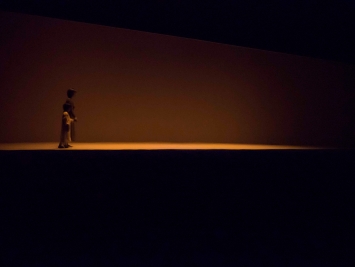 |
| L'Intérieur, directed by Claude Régy for the Festival d'Automne |
Maurice Maeterlinck wrote Intérieur in 1894 for marionettes, and
Claude Régy first directed the play in 1985 with a French cast. Tonight I saw
Régy’s revisited production with Japanese actors from the Shizuoka Performing
Arts Center. Though I can imagine the play with marionettes, it’s hard to
imagine the fragmented, almost mechanically pronounced words of this short play
being spoken in French by French actors. The Japanese cast, speaking in very
resonant, almost musical tones was perfect. It was as though they held the
resonance of Maeterlinck’s words translated into Japanese in their voices which
were, in turn, held in their bodies as vessels. The spoken dialogue is sparse,
simple, factual almost, and yet it too, like the voices that reverberate in the
bodies of the actors, is profound. They announce statements that expland well
beyond the events taking place on stage, such as the old man’s warning: « Prenez garde ; on ne sait pas jusqu’où l’âme
s’étend autour des hommes »
 |
| L'Intérieur, Directed by Claude Régy for the Festival d'Automne |
The beauty of this production is in the
slow, silences of the staging. A family—a mother, father, two girls and a
child—are in their house, and the most significant event in the moment is that
their child sleeps. “Outside” the “house,” a separation of spaces that is bare,
but distinct, on Régy’s stage, some people comment on what is taking place
inside the house. And then, they must tell the family that one of their
daughters has drowned in a nearby pond. But how?
 |
| L'Intérieur, Directed by Claude Régy for the Festival d'Automne |
It’s a play about death. Played out in the
tension between inside and outside the house, the Japanese actors in this
version of the play are like ghosts. Dressed in simple clothes, most of the
time, they walk on white sand, slowly so that we can hear every footstep, the
sand underneath their shoes. The silence of the step was loud in a theatre full
of people so still. The silence of the step became a language of its own. The
light changed very subtley, slightly, so there were times we could see the
actors’ faces, until it faded away again and they became silhouettes. And there
were times when the translucent light of the night was blue, at others, the
characters were walking slowly, through a world of yellow.
Although the words are profound, I was struck
that in a piece focused so specifically on death, how it happens, how to live
in the presence of death, what it means, how it transforms the lives of those
around it, and so on, there was a distinct absence of melancholia, even
mourning. In fact, all emotion was held in the performance, as well as the
meaning of the words. Apparently, Régy and the actors have no language in
common. He directed a cast without speaking their language. Surely this must
contribute to the importance of the resonances and sonorities of the language, making
them as heavy as the meaning of the words? Together with the meditative like
movements and the haunting, mysterious light, the unique use of a foreign
language created an indistinction between conscious and unconscious. This
created further distance from the language, allowing the light, the stage, the
characters’ movement to fill spaces beyond language. And it was in these spaces
that the most significant things were communicated.
No comments:
Post a Comment